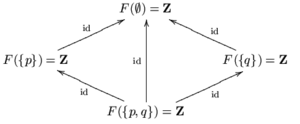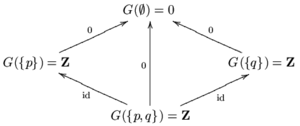- Constant sheaf
-
In mathematics, the constant sheaf on a topological space X associated to a set A is a sheaf of sets on X whose stalks are all equal to A. It is denoted by A or AX. The constant presheaf with value A is the presheaf that assigns to each open subset of X the value A, and all of whose restriction maps are the identity map A → A. The constant sheaf associated to A is the sheafification of the constant presheaf associated to A.
In certain cases, the set A may be replaced with an object A in some category C (e.g. when C is the category of abelian groups, or commutative rings).
Constant sheaves of abelian groups appear in particular as coefficients in sheaf cohomology.
Basics
Let X be a topological space, and A a set. The sections of the constant sheaf A over an open set U may be interpreted as the continuous functions U → A, where A is given the discrete topology. If U is connected, then these locally constant functions are constant. If f: X → {pt} is the unique map to the one-point space and A is considered as a sheaf on {pt}, then the inverse image f−1A is the constant sheaf A on X. The sheaf space of A is the projection map X × A → X (where A is given the discrete topology).
A detailed example
Let X be the topological space consisting of two points p and q with the discrete topology. X has four open sets: ∅, {p}, {q}, {p, q}. The five non-trivial inclusions of the open sets of X are shown in the chart.
A presheaf on X chooses a set for each of the four open sets of X and a restriction map for each of the nine inclusions (five non-trivial inclusions and four trivial ones). The constant presheaf with value Z, which we will denote F, is the presheaf which chooses all four sets to be Z, the integers, and all restriction maps to be the identity. F is a functor, hence a presheaf, because it is constant. Each of the restriction maps is injective, so F is a separated presheaf. F satisfies the gluing axiom, but it is not a sheaf because it fails the local identity axiom on the empty set. This is because the empty set is covered by the empty family of sets: Vacuously, any two sections of F over the empty set are equal when restricted to any set in the empty family. The local identity axiom would therefore imply that any two sections of F over the empty set are equal, but this is not true.
A similar presheaf G which satisfies the local identity axiom over the empty set is constructed as follows. Let G(∅) = 0, where 0 is a one-element set. On all non-empty sets, give G the value Z. For each inclusion of open sets, G returns either the unique map to 0, if the smaller set is empty, or the identity map on Z.
Notice that as a consequence of the local identity axiom for the empty set, all the restriction maps involving the empty set are boring. This is true for any presheaf satisfying the local identity axiom for the empty set, and in particular for any sheaf.
G is a separated presheaf which satisfies the local identity axiom, but unlike F it fails the gluing axiom. {p, q} is covered by the two open sets {p} and {q}, and these sets have empty intersection. A section on {p} or on {q} is an element of Z, that is, it is a number. Choose a section m over {p} and n over {q}, and assume that m ≠ n. Because m and n restrict to the same element 0 over ∅, the gluing axiom requires the existence of a unique section s on G({p, q}) which restricts to m on {p} and n on {q}. But because the restriction map from {p, q} to {p} is the identity, s = m, and similarly s = n, so m = n, a contradiction.
G({p, q}) is too small to carry information about both {p} and {q}. To enlarge it so that it satisfies the gluing axiom, let H({p, q}) = Z ⊕ Z. Let π1 and π2 be the two projection maps Z ⊕ Z → Z. Define H({p}) = im(π1) = Z and H({q}) = im(π2) = Z. For the remaining open sets and inclusions, let H equal G. H is a sheaf called the constant sheaf on X with value Z. Because Z is a ring and all the restriction maps are ring homomorphisms, H is a sheaf of commutative rings.
References
- Section II.1 of Hartshorne, Robin (1977), Algebraic Geometry, Graduate Texts in Mathematics, 52, New York: Springer-Verlag, ISBN 978-0-387-90244-9, MR0463157
- Section 2.4.6 of Tennison, B.R. (1975), Sheaf theory, ISBN 9780521207843
Categories:- Sheaf theory
Wikimedia Foundation. 2010.




